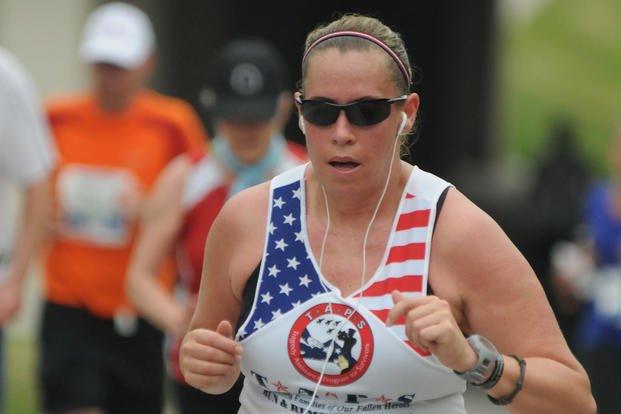I received an email from an Army soldier who was having a difficult time running a few months ago. His breathing patterns were so erratic that he basically was hyperventilating while on his two-mile physical fitness test run. Once he started breathing properly and exhaling fully, he performed better.
"It finally clicked," the soldier said. "Not only was I able to breathe and finish while running, but I was able to run faster without getting tired or cramped at all."
Learning to breathe during exercise has benefits, such as preventing dizziness during activity, improving athletic performance and increasing fat burning.
What is proper breathing while running?
Many experts will say that to oxygenate the muscles and clear the body of carbon dioxide fully, you should breathe a 3:2 inhale-to-exhale ratio; full inhales and full exhales. This means you inhale on the left, right, left foot strikes and exhale fully on the right, left foot strikes.
This pattern is not that hard to turn into a habit, but it may require you to slow down for a few runs to master the technique. You will notice a lower heart rate as you get more oxygen in and more importantly push all the carbon dioxide out of your body.
You may notice that you naturally drop to a 2:1 ratio when you are pushing it to the finish. That is OK. But realize it is difficult to maintain a pace that requires you to breathe at a 2:1 ratio. The CO2 in your body will increase if your breathing patterns are short and hurried. This will increase your heart rate and lactic-acid production, and decrease your endurance in any cardiovascular event (running, swimming, biking, etc.)
What about breathing and PT/lifting?
Proper breathing during exercises where you exert yourself -- such as lifting, pushing or pulling -- is much easier to remember and control than the 3:2 ratio during running long distance. Always exhale on exertion. When you are pushing a barbell off the chest during the bench press, you exhale on the push and inhale as you bring it slowly down.
When you are doing a pull-up, you exhale on the pulling up motion and inhale on the way down. Breathing during exertion is important in preventing internal injury such as hernia, blood vessel strain and high blood pressure. Because weightlifting and PT can be potentially harmful when done incorrectly, it is advised to get clearance from a doctor before performing too much, too soon. To decrease that pressure, focus on breathing deep all the time -- during workouts and in your daily activities.
How does more oxygen help burn more fat?
Basically, the body needs water and increased oxygen to burn fat as an energy source. The water intake should be anywhere from a half gallon for women and up to one gallon a day for men, and the increased oxygen consumption will assist with the other part of the equation. See the "Water Plus Oxygen Equals Weight Loss" article if you are concerned about drinking too much.
As you add more water and oxygen to your system, your body will use the retained water for excretion, prompting almost immediate weight loss of retained water and toxins. This is not the same as sitting in a sauna and sweating, which actually dehydrates you. Adding water will rehydrate you and enable the body to burn more fat (as long as you increase your oxygen intake by doing some form of exercise). Walking, swimming, biking, jogging, calisthenics and even yard work can help with working your cardiovascular system.
Try the deep breathing rhythm during running and see for yourself how you will run at a lower heart rate and have more energy for a strong finish.
Stew Smith is a former Navy SEAL and fitness author certified as a Strength and Conditioning Specialist (CSCS) with the National Strength and Conditioning Association. Visit his Fitness eBook store if you're looking to start a workout program to create a healthy lifestyle. Send your fitness questions to stew@stewsmith.com.
Want to Learn More About Military Life?
Whether you're thinking of joining the military, looking for fitness and basic training tips, or keeping up with military life and benefits, Military.com has you covered. Subscribe to Military.com to have military news, updates and resources delivered directly to your inbox.


















